Browse using the new Vinous website now. Launch →
Printed by, and for the sole use of . All rights reserved © 2015 Vinous Media
Vinous Icons: Roederer – Four Decades of Cristal & Cristal Rosé
BY ANTONIO GALLONI | NOVEMBER 21, 2024
This retrospective tasting of Cristal and Cristal Rosé at Le Bernardin during the inaugural edition of Vinous Icons was a fabulous opportunity to taste a series of reference point vintages paired with Eric Ripert’s dazzling cuisine. Could there be a better way to spend a Friday afternoon? I think not.
Although pretty much a lifelong fan of the wines, I started reviewing Champagne formally in 2008. Jean-Baptiste Lécaillon was the first Chef de Cave I tasted within my new beat. One rainy fall Saturday morning we met in New York City for a vertical of Cristal back to 1982. It was an incredible tasting, but not my first experience with older Cristals. A few years before that I tasted the 1979 in a flight of all the great Champagnes of that vintage. That’s when I became seriously hooked.
In the years that followed, annual visits led me to conclude that Champagne Louis Roederer was slowly reinventing itself, taking the innovative spirit of the grower Champagne movement and bringing the best of those concepts to one of Champagne’s most elite grand marques. The biggest changes were in farming. I had a chance to follow see that evolution firsthand. Vin clair tastings included comparisons of wines from the same vineyard in sections farmed conventionally versus organically. In time, those tastings developed into comparisons of wines from the same vineyards, but from organic biodynamic parcels. Fast forward to today. Roederer farms more vineyards biodynamically than any house in Champagne, small or large, including all of the parcels that are used in Cristal and Cristal Rosé.
The range also expanded meaningfully. Roederer added two Brut Nature Champagnes, introduced a Vinothèque program, launched two Coteaux Champenois and released Collection, a modern-day interpretation of what used to be Brut Premier. That's an enormous amount of change in a relatively short time, but also illustrative of the spirit of innovation Lécaillon has brought to the maison. Readers will find extensive information on Lécaillon’s illustrious career and technical details on how Cristal and Cristal Rosé are made in the articles linked below.
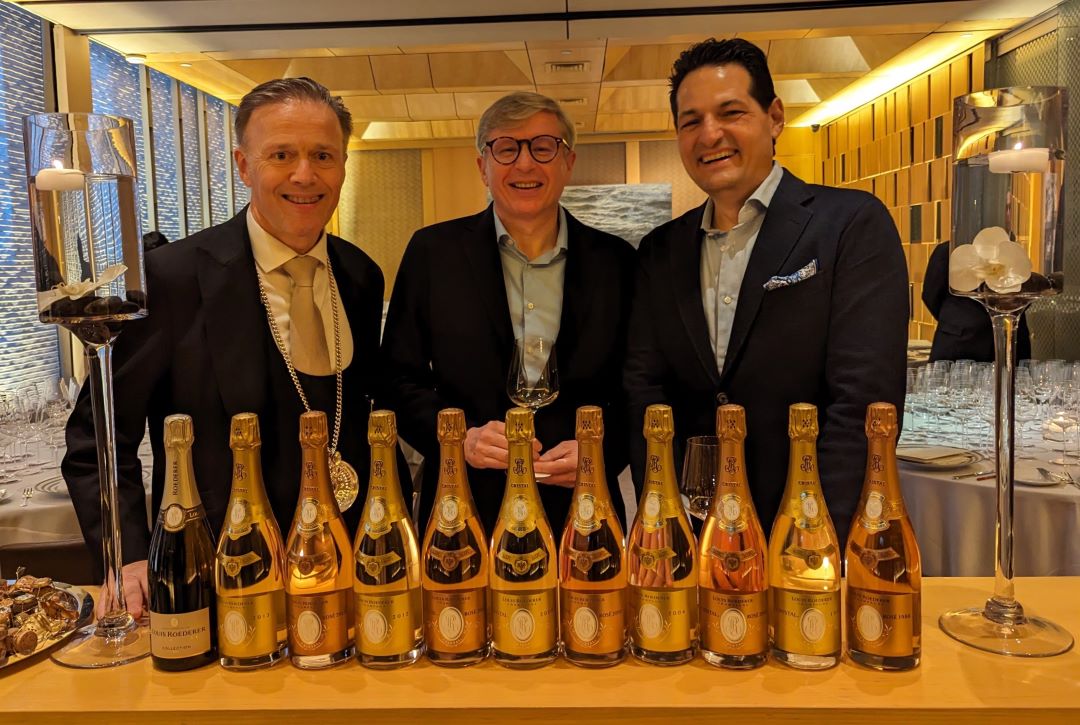
With Aldo Sohm, Le Bernardin's longtime Wine Director (left), and Roederer Chef de Cave Jean-Baptiste Lécaillon (center).
For this lunch, we decided to taste Cristal and Cristal Rosé side-by-side across several of the most important vintages of the last 20 years or so, something that is rarely done because pairing food for both wines at the same time is so challenging. The only exception was the last flight, as the wines were from different vintages. We opened the wines about an hour prior to lunch. I tasted through each bottle with Aldo Sohm, Le Bernardin’s longtime Wine Director. Chef/Owner Eric Ripert and his team prepared a brilliant menu. I have worked with many chefs and sommeliers on our events, but have rarely, if ever, seen this much attention to food and pairings. That time paid off, as the pairings were sublime.
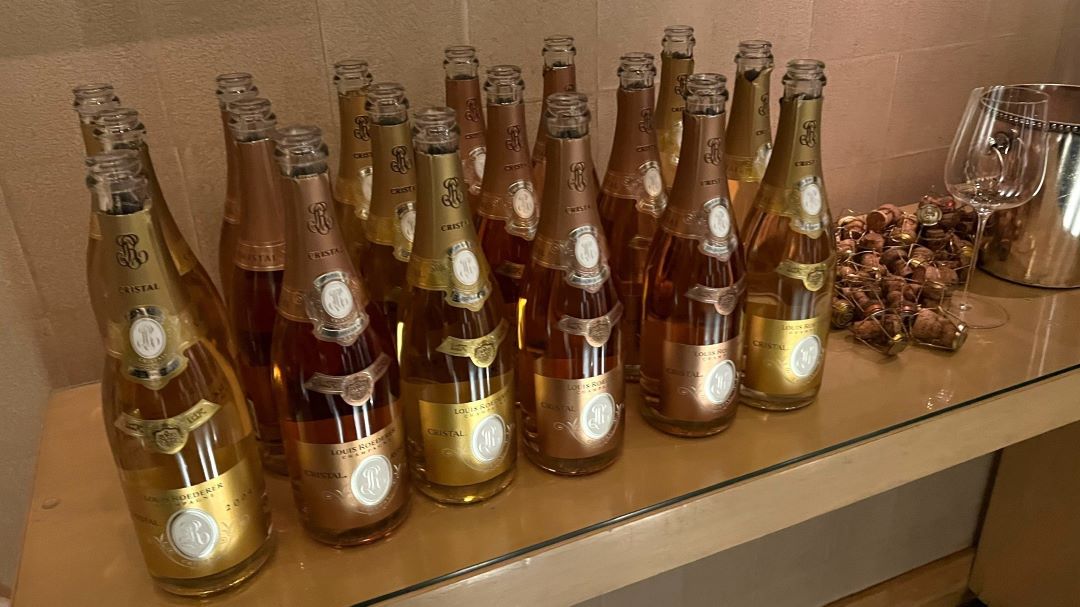
Tasting through each bottle just prior to service.
Passed Canapés
NV Collection 244
The room is buzzing as guests start to arrive. A glass of the NV Collection 244 sets the mood. Collection is a new Champagne from Roederer, essentially the former Brut Premier reinterpreted with a focus on freshness and verve. Those qualities come alive in the glass. Brisk acids cut through a core of orchard fruit, chamomile and crushed rocks. What a beautiful and expressive wine this is.
First Course
Layers of Thinly Pounded Yellowfin Tuna; Foie Gras, Toasted Baguette, Chives
2012 Cristal & 2012 Cristal Rosé
I chose the 2012s to start, as the wines have always been quite open and seductive. That is very much the case today. Interestingly, the 2012 vintage did not have much of a buzz when I began tasting the vins clairs in the spring of 2013. The bottled, finished Champagnes paint a very different and much more exciting picture.
The 2012 Cristal is quite delicate and floral, with hints of pear and white flowers that add considerable allure. This is a young Cristal still in its infant stage, but it’s a Champagne that can be enjoyed now. In this setting, the 2012 Cristal Rosé is a cut above the 2012 Cristal. The Rosé’s explosive energy and vibrancy are both compelling and a very fine match for the food. Time in the glass brings out the breadth and creaminess of the year. The blend is 55% Pinot Noir from Aÿ and 45% Chardonnay from Mesnil and Avize. This is a terrific showing. We are off to the races.
The Layers of Thinly Pounded Yellowfin Tuna; Foie Gras, Toasted Baguette and Chives, is a Le Bernardin signature dish that never disappoints. It’s classic Eric Ripert all the way.
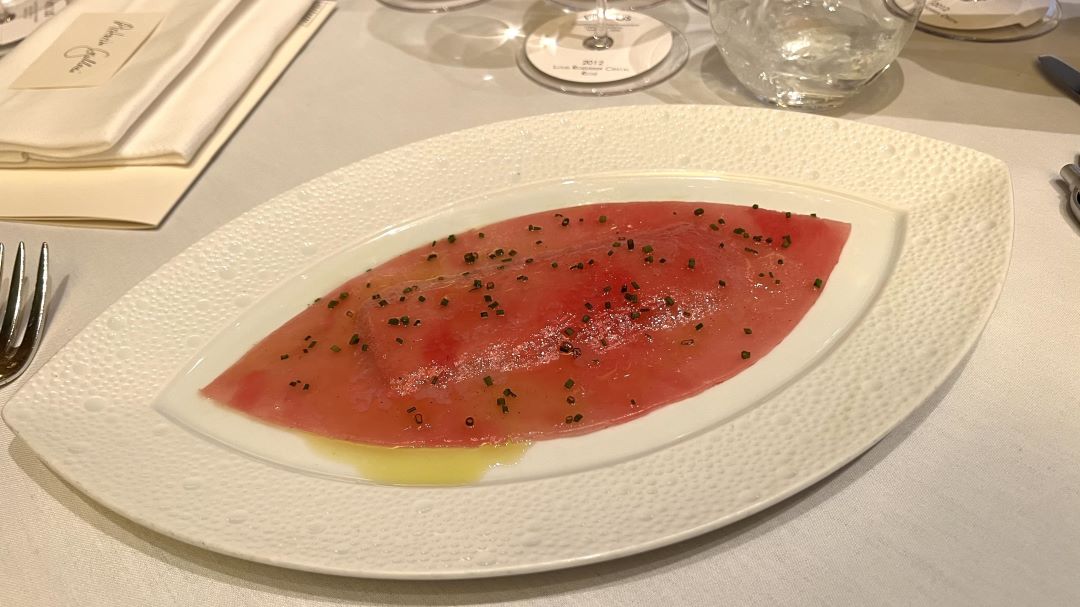
A Le Bernardin signature: Layers of Thinly Pounded Yellowfin Tuna; Foie Gras, Toasted Baguette, Chives.
Second Course
Baked Striped Bass; Seasonal Mushroom Casserole “au Jus”
2013 Cristal & 2013 Cristal Rosé
2008 Cristal & 2008 Cristal Rosé
One of the things we strive to deliver at our events is high educational content. For that reason, I thought comparing Cristal and Cristal Rosé across the 2013 and 2008 harvests would be incredibly enlightening. Both are vintages with October harvests, a rarity today. The main difference between the two seasons is that 2013 had more heat during summer, while 2008 was cooler during the entire year. As a result, the 2013s generally offer a super-appealing combination of brisk acids and dense fruit, while the 2008 are decidedly leaner and more classically austere.
A dense, explosive Champagne, the 2013 Cristal is a picture-perfect example of the year. Ripe pear, tangerine oil, white flowers and crushed rocks are all beautifully amplified. There is an exotic quality to the 2013 that simply can’t be denied. Interestingly, the 2013 Cristal Rosé is more austere than the Blanc. It has plenty of vibrant energy and steeliness but also a touch less generosity today. I suspect the 2013 is going through a period of closure, which I take as a positive sign for its long-term prospects and aging potential—likely to be measured in decades rather than years.
The 2008 Cristal is just fabulous. Chiseled and nuanced to the core, the 2008 possesses dazzling intensity from start to finish. Crushed rocks, lemon peel, graphite, mint, lime, chalk and white flowers all race across the palate. This is classic Cristal in a cool, late-ripening year. The 2008 Cristal Rosé is unquestionably one of the greatest wines longtime Chef de Cave Jean-Baptiste Lécaillon has made at Roederer. Bright saline and chalky notes run through a core of vibrant, red-toned fruit. The 2008 is tightly wound and nervous, yet it also has more than enough depth to keep it from being overly austere. Today, it is once again magnificent. Unforgettable.
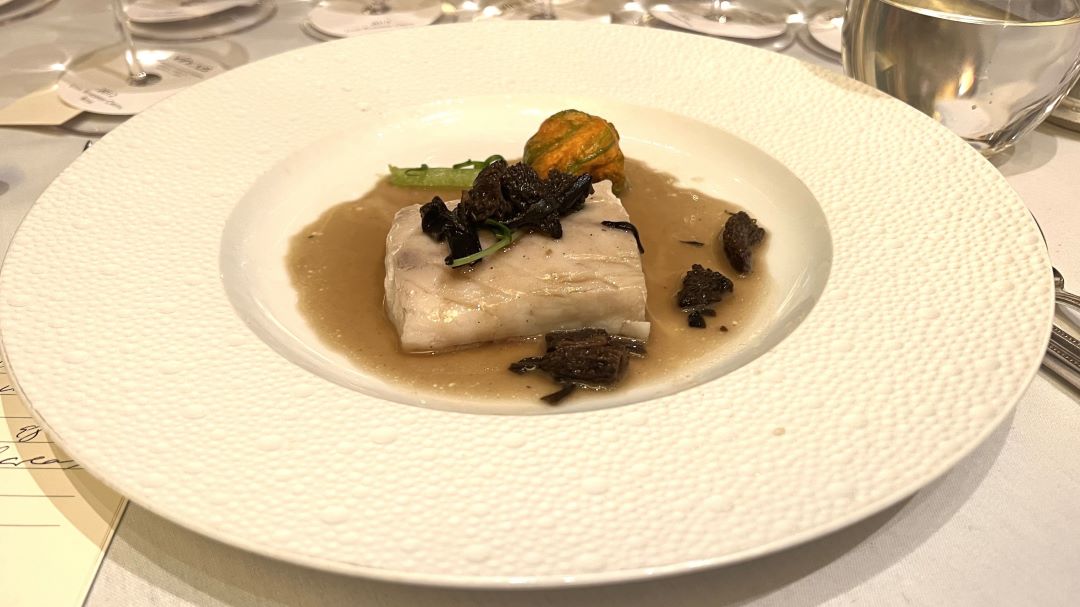
Baked Striped Bass; Seasonal Mushroom Casserole “au Jus.”
Intermezzo
2004 Cristal & 2004 Cristal Rosé
The two 2004s are served as a sort of intermezzo, a bridge to the older Champagnes in this tasting. Two thousand and four was a controversial vintage in Champagne back in the day. After a brutal year in 2003, vines responded by setting a very large crop. These were the highest yields ever recorded in Champagne. The 2004s have always had a linear construction and an element of freshness I admire, which is why I rated many of them very favorably. Time has only served to reinforce my early impressions.
The 2004 Cristal is nuanced and classy right out of the gate. Hints of lemon confit, marzipan, tangerine oil, spice and chamomile are all suggestive of a Champagne that has arrived at its first inflection point of early maturity. The interplay of slightly more mature notes with a good deal of freshness makes for an incredibly delicious wine to enjoy now. As it turns out, I tasted the 2004 again the following day and found it even more vibrant than the bottles we served at this lunch. The 2004 Cristal Rosé is also stellar. Here, time in bottle has added textural depth and Pinot Noir resonance without detracting from the wine’s essential tension and cut. Crushed rocks, white pepper, kirsch, mint and red plum fruit all race across the palate. I would love to spend all day with this. The 2004 Rosé has always been special. Today, it is in especially fine shape. At times, I get the feeling it is getting younger with age!
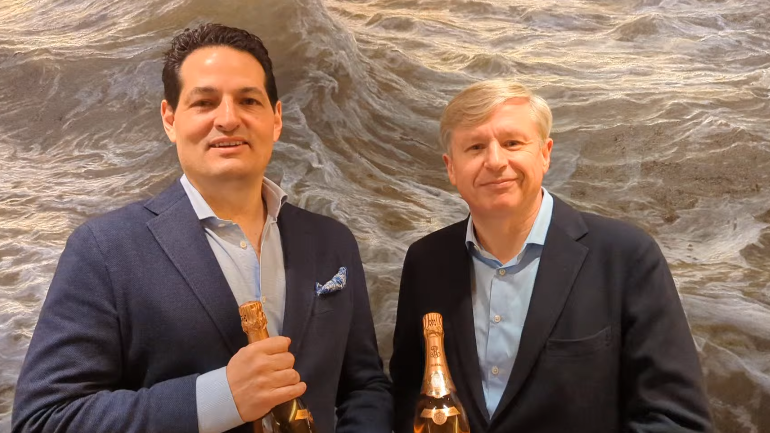
Video: Chat with Roederer Chef de Cave Jean-Baptiste Lécaillon just before lunch.
Third Course
Poached Lobster; Truffled Gnocchi, Natural Jus au Poivre
1990 Cristal 2008 Cristal & 1988 Cristal Rosé
This last flight is mesmerizing. The 1990 Cristal is a rich, exotic beauty. Apricot, tangerine oil, spice and baked pastry are all signatures of a mature Champagne. Even so, the 1990 is fresh, vibrant and full of life. Its volume and resonance make it impossible to resist a second taste, and then a third. The 1990 is a transitional Cristal, made by Chef de Cave Michel Pansu with a young Jean-Baptiste Lécaillon learning the ropes at his side.
The 1988 Cristal Rosé might be even better than the 1990 Cristal served alongside it. I admire its ability to transmit concentration and depth while remaining light on its feet. Blood orange, mint, white pepper, tangerine and crushed rocks all saturate the palate. Both wines are simply exceptional. They are also sublime with the food, the wines elevating the dish and vice versa. This inspired pairing left me and our guests absolutely thrilled. What a great way to conclude this lunch.
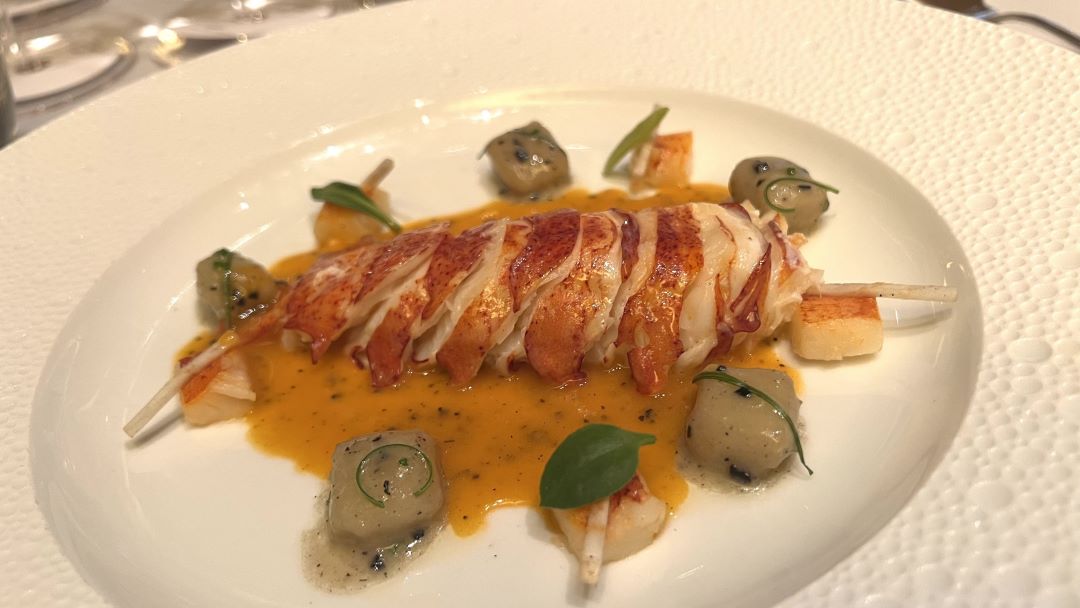
Poached Lobster; Truffled Gnocchi, Natural Jus au Poivre.
Fourth
Hazelnut; Chocolate Waffle Cone, Peruvian Chocolate Ice Cream
Le Bernardin’s Peruvian Chocolate Ice Cream was a suitably rich conclusion to this superb lunch. We did not serve Champagne with dessert, as this is not something I am a fan of. So, we picked the best dessert on the menu and left it at that.
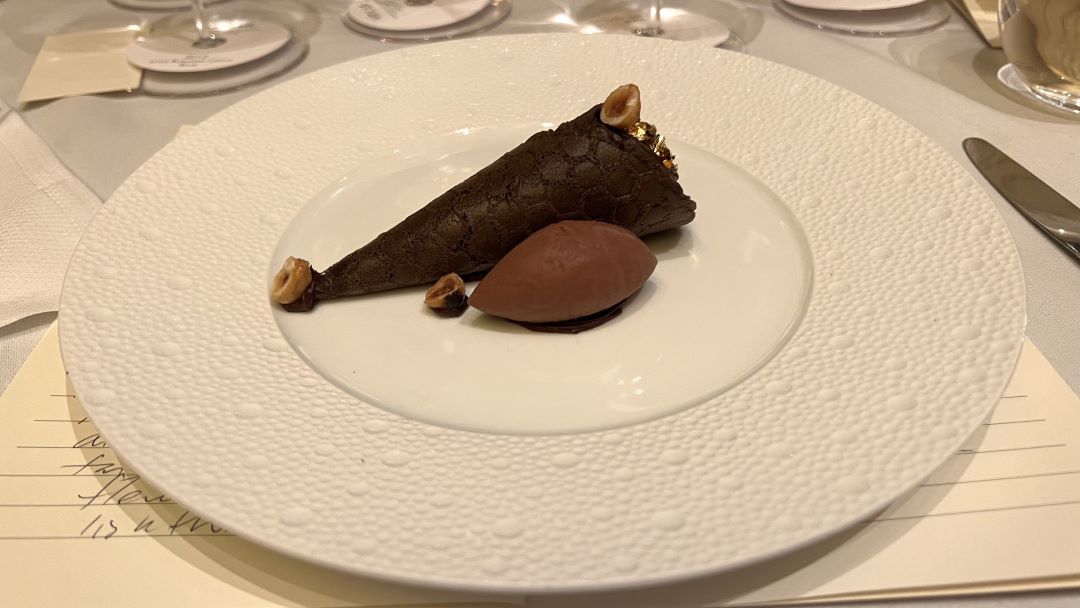
Hazelnut; Chocolate Waffle Cone, Peruvian Chocolate Ice Cream, with tasting notes in the background.
Over the years, I have been fortunate to taste more than my fair share of older vintages of Cristal and Cristal Rosé. The Vinous database includes 150 reviews for these wines across 36 vintages for Cristal and 17 for Cristal Rosé, all chronicled in the articles below. Aged wines have an undeniable fascination. They have a story to tell, an ability to transport us to another time. That said, it is easy to over-romanticize older wines, to think those wines represent a time when things were better than they are today. Based on the sheer quality, precision and consistency of the wines today, I am convinced the Golden Age of Cristal and Cristal Rosé is right now.
© 2024, Vinous. No portion of this article may be copied, shared or re-distributed without prior consent from Vinous. Doing so is not only a violation of our copyright, but also threatens the survival of independent wine criticism.
You Might Also Enjoy
Roederer Cristal Full Circle: 1993-2015, Antonio Galloni, December 2023
2022 – The Year in Review, Antonio Galloni, December 2022
Cristal in Magnum: It’s Another World, Antonio Galloni, December 2019
Cristal – The 1980s…A Decade of Change, Antonio Galloni, December 2018
Roederer Cristal: That ’70s Show, Antonio Galloni, June 2017
Roederer Cristal Rosé: A Journey Through Time 1976-2007, Antonio Galloni, May 2015
A Survey of Cristal: 1979-2002, Antonio Galloni, January 2009
